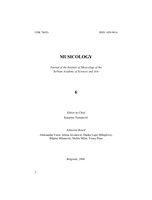Временска димензија епских песама
The Temporal Dimension of Epic Songs
Author(s): Danka Lajić-MihajlovićSubject(s): Customs / Folklore, Music, Cultural Anthropology / Ethnology, History of Art
Published by: Muzikološki institut SANU
Keywords: epic songs with fiddle; melopoetic structure; poetic component; musical component; time; pace; rhythm; individual style; symmetry - asymmetry; evolution of style: "old" - "new";
Summary/Abstract: Since research into south-Slav epic songs began, finding its place within philological sciences, the musical component has been marginalised. In extreme cases the correlation between poetry and music was even denied. In the relatively few (ethno)musicological works dealing with the epic songs, that correlation was observed mainly on the macro-formal level. The author maintains that any systematic research of the functional melopoetic structure of Serbian epic songs should include the temporal features of music. The article is an essay on the methodology in which the poetry–music relationship is investigated from the point of view of their temporal dimension. The flow of music–poetry content is observed from the perspectives of tempo and rhythm, primarily as relations between durations on different structural levels. The chosen examples consist of two variants of an epic song, typical of their kind, which have the same subject and structural bases. The performers were two gusle-players, so that the performing bodies were the same. In the course of analysis, focus was directed on the musical equivalents of elements of poetic structure considered to be constant, or at least showing strong tendencies towards expression in verse forms. The analysis demonstrated that the musical component was the critical value needed to differenciate the systems of relations between the poetic and musical components, i.e. styles of interpretation. The chosen individual styles represent contrasting approaches to the organisation of the poetic content in time. Although the temporal dimension in both examples is semanticised, its values in those styles are diametrically different. At one extreme a construction is found in which the relation of morphological unit values on poetical and musical levels demonstrates a specific interaction on the structural level. The symmetry on the macro plan depends on the constancy of the verse length, but it cannot be maintained that music is fully in the service of poetry. The reason for that is to be found mainly in the (isochrone) basis of the melopoetic, i.e. musical rhythm that, contrary to expectation (in view of the primary function of epic songs), is not achieved according to the dynamics of speech. The causes of such non-correspondence could be detected in the archaic links of epic songs with genres possessing characteristic rhythms of movement, first of all with rituals belonging to the death cycle, and/or changes in the prosody of the Serbian language. The other extreme is to be found in a style that represents, in a certain way, a quality development in the process of transfering the structural centre of gravity from poetry to music. It should be added that in the course of that process the semantics of that style’s temporal dimension on the macro-plan stays in closest relation with the structure of verse and syntax. The key noncorrespondence of durations of spoken and sung syllables demands wider elaboration of the relation between the rhythm of poetry and music. While not denying the importance of regional differences, the author finds more probable the hypothesis that the key differences between the researched styles are linked to their development, from sinpractical to sinlogical, “from representation to understanding”, i.e. the hypothesis of the polystadiality of Serbian epic tradition. The application of the results of this research on a wider historical/stylistic scale should be aproached cautiously, not only because of the scope of the given examples, but primarily because of links with the problematic chronology of the musical-aesthetic phenomena of symmetry and asymmetry, the “evolutive” and “architectonic” priciples of structural construction.
Journal: Muzikologija
- Issue Year: 1/2006
- Issue No: 6
- Page Range: 343-364
- Page Count: 22
- Language: Serbian

